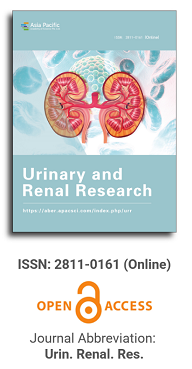
Asia Pacific Academy of Science Pte. Ltd. (APACSCI) specializes in international journal publishing. APACSCI adopts the open access publishing model and provides an important communication bridge for academic groups whose interest fields include engineering, technology, medicine, computer, mathematics, agriculture and forestry, and environment.
Bioinformatics analysis of the muscle-invasive bladder cancer subtypes
Vol 3, Issue 1, 2022
Download PDF
Abstract
Objective In order to improve the accuracy in distinguishing subtypes of bladder cancer and to explore its potential therapeutic targets, we identify differences between two kinds of bladder cancer subtypes (basal-like and luminal) in molecular mechanism and molecular characteristics based on the bioinformatics analysis. Methods In this study, the RMA (robust multichip averaging) was applied to normalize the mrna profile which included 22 samples from basal-like subtype and 132 from luminal subtype, and the differential expression analysis of genes with top 1000 highest standard deviation was performed. Then, the Gene Ontology and KEGG pathway enrichment analysis of differentially expressed genes was performed. In addition, the protein-protein interactions networks analysis for the top 100 most significant differentially expressed genes was performed. Results A total of 742 differentially expressed genes distinguishing basal-like and luminal subtypes were found, of which 405 were up-regulated and 337 genes were down-regulated in basal-like subtype. GO enrichment analysis showed that differentially expressed genes were significantly enriched in the extracellular matrix, chemotaxis and inflammatory response. KEGG pathway enrichment analysis showed that the differentially expressed genes were significantly enriched in the pathway of extracellular matrix receptor interaction. The hub proteins we founded in protein-protein interaction networks were LNX1, MSN and PPARG. Conclusions In this study, the mainly difference of molecular mechanism between basal-like and luminal subtypes are alteration in extracellular matrix region, cell chemotaxis and inflammatory response. Genes such as LNX1, MSN and PPARG were forecast to play important roles in the classification of bladder carcinoma subtypes.
Keywords
References
- Bryan RT. Update on bladder cancer diagnosis and management[J]. Trends in Urology & Mens Health, 2013, 4(5) : 7–11.
- Mao JW, Li QW. Progress in the treatment of muscular invasive bladder cancer[J]. Chinese Journal of General Practice, 2013, 11 (5) : 778-780.
- Kaufman DS, Shipley WU, Feldman AS. Bladder cancer [J]. Lancet, 2009, 374(374) : 239-249.
- Xing AI, Jia Z, Wang J, et al. Bioinformatics analysis of the target gene of fibroblast growth factor receptor 3 in bladder cancer and associated molecular mechanisms[J]. Oncology Letters, 2015, 10 (1) : 543-549.
- Martin-Doyle W, Kwiatkowski DJ. Molecular biology of bladder cancer[J]. Hematology/oncology Clinics of North America, 2015, 29(2) : 5-12.
- The Cancer Genome Atlas Research Network. Comprehensive Molecular Characterization of Urothelial Bladder Carcinoma[J]. Nature, 2014, 507(7492) : 315-322.
- Choi W, Porten S, Kim S, et al. Identification of distinct basal and luminal subtypes of muscle-invasive bladder cancer with different sensitivities to frontline chemotherapy[J]. Cancer Cell, 2014, 25(2) : 152-65.
- Choi W, Czerniak B, Ochoa A, et al. Intrinsic basal and luminal subtypes of muscle-invasive bladder cancer[J]. Nature Reviews Urology, 2014, 11(7) : 400-410.
- Damrauer JS, Hoadley KA, Chism DD, et al. Intrinsic subtypes of high-grade bladder cancer reflect the hallmarks of breast cancer biology[J]. Proceedings of the National Academy of Sciences of the United States of America, 2014, 111(8) : 3110-3115.
- Biton A, Bernardpierrot I, Lou Y, et al. Independent component analysis uncovers the landscape of the bladder tumor transcriptome and reveals insights into luminal and basal subtypes [J]. Cell Reports, 2014, 9(9) : 1235-1245.
- Hu CX, Zhang JR, Huang LH, et al. Application of cyclic adenosine monophosphate in clinical application of tumor[J]. Tianjin Pharmacy, 2013, 25(6) : 49-52.
- Guo ZG, Gao YH. Expression, activity determination of ubiquitin ligase LNX1 and primary study on its function[J]. Letters in Biotechnology, 2012, 23(4) : 523-526.
- Wang CC, Liau JY, Lu YS, et al. Differential expression of moesin in breast cancers and its implication in epithelial-mesenchymal transition[J]. Histopathology, 2012, 61(61) : 78-87.
- Conconi D, Panzeri E, Redaelli S, et al. DNA copy number alterations and PPARG amplification in a patient with multifocal bladder urothelial carcinoma[J]. BMC Research Notes, 2012, 5 (1) : 607.
- Mansure J J, Nassim R, Chevalier S, et al. A novel mechanism of PPAR gamma induction via EGFR signalling constitutes rational for combination therapy in bladder cancer[J]. Plos ONE, 2013, 8 (2) : e55997.
- Li ZY. Extracellular matrix and bladder tumor metastasis[J]. International Journal of Urology and Nephrology, 2012, 32 (3) : 363-367.
- Yan S, Yang X, Chen T, et al. The PPAR γ agonist troglitazone induces autophagy, apoptosis and necroptosis in bladder cancer cells[J]. Cancer Gene Therapy, 2014, 21(5) : 188-193
Supporting Agencies
Copyright (c) 2022 Wenbin Xu, Weiying Zheng, Hong Xia, Lin Hua

This work is licensed under a Creative Commons Attribution-NonCommercial 4.0 International License.

This site is licensed under a Creative Commons Attribution 4.0 International License (CC BY 4.0).
.png)
Prof. Wei-Yen Hsu
National Chung Cheng University, Taiwan

